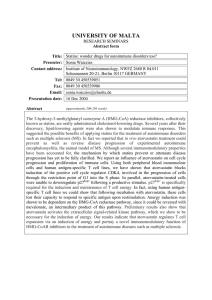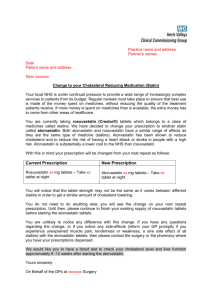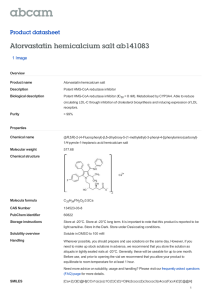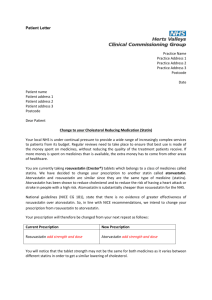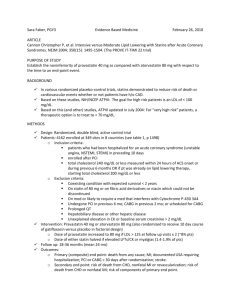Document 13310676
advertisement
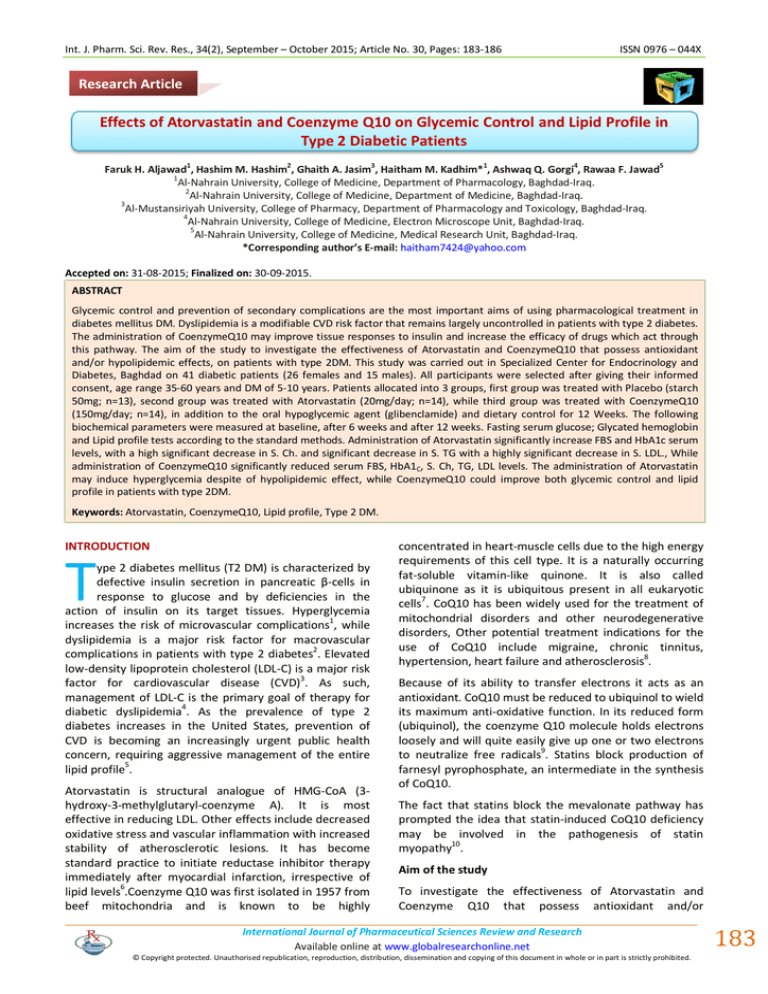
Int. J. Pharm. Sci. Rev. Res., 34(2), September – October 2015; Article No. 30, Pages: 183-186 ISSN 0976 – 044X Research Article Effects of Atorvastatin and Coenzyme Q10 on Glycemic Control and Lipid Profile in Type 2 Diabetic Patients 1 2 3 1 4 5 Faruk H. Aljawad , Hashim M. Hashim , Ghaith A. Jasim , Haitham M. Kadhim* , Ashwaq Q. Gorgi , Rawaa F. Jawad 1 Al-Nahrain University, College of Medicine, Department of Pharmacology, Baghdad-Iraq. 2 Al-Nahrain University, College of Medicine, Department of Medicine, Baghdad-Iraq. 3 Al-Mustansiriyah University, College of Pharmacy, Department of Pharmacology and Toxicology, Baghdad-Iraq. 4 Al-Nahrain University, College of Medicine, Electron Microscope Unit, Baghdad-Iraq. 5 Al-Nahrain University, College of Medicine, Medical Research Unit, Baghdad-Iraq. *Corresponding author’s E-mail: haitham7424@yahoo.com Accepted on: 31-08-2015; Finalized on: 30-09-2015. ABSTRACT Glycemic control and prevention of secondary complications are the most important aims of using pharmacological treatment in diabetes mellitus DM. Dyslipidemia is a modifiable CVD risk factor that remains largely uncontrolled in patients with type 2 diabetes. The administration of CoenzymeQ10 may improve tissue responses to insulin and increase the efficacy of drugs which act through this pathway. The aim of the study to investigate the effectiveness of Atorvastatin and CoenzymeQ10 that possess antioxidant and/or hypolipidemic effects, on patients with type 2DM. This study was carried out in Specialized Center for Endocrinology and Diabetes, Baghdad on 41 diabetic patients (26 females and 15 males). All participants were selected after giving their informed consent, age range 35-60 years and DM of 5-10 years. Patients allocated into 3 groups, first group was treated with Placebo (starch 50mg; n=13), second group was treated with Atorvastatin (20mg/day; n=14), while third group was treated with CoenzymeQ10 (150mg/day; n=14), in addition to the oral hypoglycemic agent (glibenclamide) and dietary control for 12 Weeks. The following biochemical parameters were measured at baseline, after 6 weeks and after 12 weeks. Fasting serum glucose; Glycated hemoglobin and Lipid profile tests according to the standard methods. Administration of Atorvastatin significantly increase FBS and HbA1c serum levels, with a high significant decrease in S. Ch. and significant decrease in S. TG with a highly significant decrease in S. LDL., While administration of CoenzymeQ10 significantly reduced serum FBS, HbA1C, S. Ch, TG, LDL levels. The administration of Atorvastatin may induce hyperglycemia despite of hypolipidemic effect, while CoenzymeQ10 could improve both glycemic control and lipid profile in patients with type 2DM. Keywords: Atorvastatin, CoenzymeQ10, Lipid profile, Type 2 DM. INTRODUCTION T ype 2 diabetes mellitus (T2 DM) is characterized by defective insulin secretion in pancreatic β-cells in response to glucose and by deficiencies in the action of insulin on its target tissues. Hyperglycemia increases the risk of microvascular complications1, while dyslipidemia is a major risk factor for macrovascular 2 complications in patients with type 2 diabetes . Elevated low-density lipoprotein cholesterol (LDL-C) is a major risk 3 factor for cardiovascular disease (CVD) . As such, management of LDL-C is the primary goal of therapy for diabetic dyslipidemia4. As the prevalence of type 2 diabetes increases in the United States, prevention of CVD is becoming an increasingly urgent public health concern, requiring aggressive management of the entire lipid profile5. Atorvastatin is structural analogue of HMG-CoA (3hydroxy-3-methylglutaryl-coenzyme A). It is most effective in reducing LDL. Other effects include decreased oxidative stress and vascular inflammation with increased stability of atherosclerotic lesions. It has become standard practice to initiate reductase inhibitor therapy immediately after myocardial infarction, irrespective of 6 lipid levels .Coenzyme Q10 was first isolated in 1957 from beef mitochondria and is known to be highly concentrated in heart-muscle cells due to the high energy requirements of this cell type. It is a naturally occurring fat-soluble vitamin-like quinone. It is also called ubiquinone as it is ubiquitous present in all eukaryotic cells7. CoQ10 has been widely used for the treatment of mitochondrial disorders and other neurodegenerative disorders, Other potential treatment indications for the use of CoQ10 include migraine, chronic tinnitus, hypertension, heart failure and atherosclerosis8. Because of its ability to transfer electrons it acts as an antioxidant. CoQ10 must be reduced to ubiquinol to wield its maximum anti-oxidative function. In its reduced form (ubiquinol), the coenzyme Q10 molecule holds electrons loosely and will quite easily give up one or two electrons to neutralize free radicals9. Statins block production of farnesyl pyrophosphate, an intermediate in the synthesis of CoQ10. The fact that statins block the mevalonate pathway has prompted the idea that statin-induced CoQ10 deficiency may be involved in the pathogenesis of statin myopathy10. Aim of the study To investigate the effectiveness of Atorvastatin and Coenzyme Q10 that possess antioxidant and/or International Journal of Pharmaceutical Sciences Review and Research Available online at www.globalresearchonline.net © Copyright protected. Unauthorised republication, reproduction, distribution, dissemination and copying of this document in whole or in part is strictly prohibited. 183 © Copyright pro Int. J. Pharm. Sci. Rev. Res., 34(2), September – October 2015; Article No. 30, Pages: 183-186 hypolipidemic effects on the changes that occur in patients with type 2 diabetes mellitus due to uncontrolled glycemic status. PATIENTS, MATERIALS AND METHODS This study was carried out on fourty one (41) patients (26 females and 15 males) with type 2 diabetes mellitus (DM) who attend the Specialized Center for Endocrinology and Diabetes-AL-Risafa Directorate of Health-Baghdad were enrolled from October 2011 to April 2013. Inclusion criteria: Patients with type 2 diabetes mellitus and hyperlipidemia of both sexes on sulfonylurea (glibenclamide), with age range 35-60 years (46.76 ± 7.89), and have disease duration of 5-10 years. Exclusion criteria: They should not have other associated chronic diseases like liver and kidney disorders and cardiovascular complications. Patients who are pregnant and breast feeding are excluded. They should not be on insulin therapy or other antidiabetic drugs, or on antioxidant drugs like aspirin, and any associated drugs should be considered. They should not taking other hypolipidemic agent; anti-inflammatory or non steroidal anti-inflammatory drugs. patients treated previously with full maximum dose of sulfonylurea (glibenclamide) (15 mg/day) and kept on dietary control, but with poor glycemic control as evidenced by abnormal values of fasting plasma glucose; glycated hemoglobin; and dyslipidemia; those patients are carefully evaluated while they are on their already established treatment program for DM control for 2 weeks before randomization into three groups: • 1- Group (A): includes 13 patients treated with placebo (starch 50 mg) in capsule dosage form in addition to the already given oral hypoglycemic agent (glibenclamide) and dietary control, for 12 Weeks. • 2- Group (B): includes 14 patients treated with Atorvastatin 20mg given as single daily doses in a tablet dosage form, in addition to the already given oral hypoglycemic agent (glibenclamide) and dietary control for 12 Weeks. • 3- Group (C): includes 14 patients treated with Coenzyme-Q10 75mg soft gelatin capsule twice daily (150mg/day) in addition to the already given oral hypoglycemic agent (glibenclamide) and dietary control for 12 Weeks. After 12 hours fasting, blood samples were collected from all subjects by venepunture (10 ml), before starting drug treatment (as base line samples) and then after 6 weeks and 12 weeks of treatment to follow the changes in the studied parameters. Serum Glucose Level (FPG) was evaluated using a readymade kit for this purpose, according to the method 11 of ; Glycated Hemoglobin (HbAlC)was evaluated using The VARIANT hemoglobin AlC program utilizes the principles of ion exchange high performance liquid ISSN 0976 – 044X 12 chromatography (HPLC) . Serum total cholesterol (T.C) was estimated according to the method of Richmond13 ; Serum Triglyceride (TG) levels were determined according 14 to the method of Fossati and Prencipe ; serum High Density Lipoprotein Cholesterol (HDL-C) levels were estimated according to the method of Burstein15 and serum Low Density Lipoprotein Cholesterol (LDL-C) was calculated by using this formula: LDL-C = Total cholesterol – (TG/2.2) – (HDL-C)16. All Results were expressed in mmol/L except of HbAlC in percent. Paired t-test and ANOVA were used to examine the degree of significance, and a value of P < 0.05 was considered significant. RESULTS The data presented in table 1 clearly showed that in comparison with value at baseline in the same group after 12 weeks of treatment, no significant difference in FBS of Placebo and Atorvastatin with a high significant decrease in FBS of Coenzyme Q10 group were recorded. In comparison with a placebo-treated group at corresponding duration, after 6 weeks of treatment there is a significant increase in FBS of Atorvastatin group and no significant difference in FBS of CO-Q10. After 12 weeks of treatment, no significant difference in FBS of Atorvastatin with a significant decrease in FBS of CO-Q10 group were recorded (Table 1). In comparison with value at baseline in the same group after 6 weeks of treatment there is significant decrease in S. HbA1c of Placebo group, a significant decrease in S. HbA1c of CO-Q10 group and significant increase in Atorvastatin group were recorded. After 12 weeks of treatment, no significant difference in S. HbA1c of Placebo and Atorvastatin groups, and a high significant decrease in S. HbA1c of CO-Q10 group recorded. In comparison with a placebo-treated group at corresponding duration, after 12 weeks of treatment, no significant difference in S. HbA1c of Atorvastatin group while a significant decrease in S. HbA1c of CO-Q10 group were seen. (Table 1). Concerning the Effect of drugs treatment on lipid profile in comparison with value at baseline in the same group after 12 weeks of treatment, there was no significant difference in s.ch, s.TG and s.HDL with a significant increase in S. LDL levels of placebo group. While a high significant decrease in S. Ch .and s.TG was found in Atorvastatin and CO-Q10 groups. No significant difference in S. HDL of Atorvastatin group and a significant increase in S. HDL of CO-Q10 group were recorded. And a high significant decrease in S. LDL of Atorvastatin, CO-Q10 groups were found. In comparison with a placebo-treated group at corresponding duration, after 12 weeks of treatment there was a significant decrease in S. Ch. was found in COQ10 group with a highly significant decrease in S. Ch. of Atorvastatin group were found. (Table 2). No significant International Journal of Pharmaceutical Sciences Review and Research Available online at www.globalresearchonline.net © Copyright protected. Unauthorised republication, reproduction, distribution, dissemination and copying of this document in whole or in part is strictly prohibited. 184 © Copyright pro Int. J. Pharm. Sci. Rev. Res., 34(2), September – October 2015; Article No. 30, Pages: 183-186 difference in S. TG of Atorvastatin and CO-Q10 groups and a significant increase in S. HDL of Atorvastatin and a high significant increase of CO-Q10group. There was no ISSN 0976 – 044X significant difference in S. LDL of CO-Q10 group and a significant decrease in S. LDL of Atorvastatin group were found. (Table 2). Table 1: Comparison of FBS and S. HBA1c at different duration of treatment in each group FBS (mmol/l) Group Placebo (n=13) Atorvastatin (n=14) CO-Q10 (n=14) S. HbA1c (%) Baseline 6 weeks 12 weeks Baseline 6 weeks 12 weeks 11.68+3.64 10.62+2.94* 11.62+2.79 8.35+1.93 8.6+1.94 8.15+1.61 11.92+3.22 14.26+4.8*a 13.27+2.88 8.19+1.24 8.83+1.39* 8.57+1.52 11.2+3.66 9.39+3.92* 8.56+2.95**a 7.81+1.49 7.11+2.25* 6.42+2.23**a Comparison is with baseline value * = Significant difference from baseline (P<0.05); ** = highly Significant difference from baseline ( P<0.001). a= significant difference (p<0.05) between drug group and placebo group at corresponding duration.; b= highly significant difference (p<0.001) between drug group and placebo group at corresponding duration. Table 2: Comparison of lipid profile at different duration of treatment in each group S. Ch.(mmol/l) Group Baseline Placebo (n=13) Atorvastatin (n=14) S. TG(mmol/l) 6 12 Weeks weeks 5.77+1.25 5.68+0.89 6.08+0.95 Baseline S. HDL(mmol/l) 6 12 Weeks weeks 1.92+0.83 2.07+1.2 2.12+0.86 Baseline S. LDL(mmol/l) 6 12 Weeks Weeks 0.99+0.3 1.16+0.21* 1.04+0.22 Baseline 6.1+0.52 5.56+0.85** 5.41+0.55**a 2.16+0.89 2.01+1.1 1.87+1.02* 1.21+0.3 12 weeks 2.72+1.02 2.51+1.01* 6.79+1.77 5.84+1.39** 4.65+1.01**b 2.55+1.53 1.76+1.04* 1.5+0.83* 1.39+0.25a 1.38+0.24a 1.39+0.29a 2.96+1.39 CO-Q10 (n=14) 6 weeks 2.38+0.56 1.17+0.2 1.49+0.13*b 3.51+0.54a 2.61+0.61** 2.94+0.96* 2.12+0.82**a 2.33+0.64** Comparison is with baseline value * = Significant difference from basline( P<0.05); ** = highly Significant difference from baseline ( P<0.001). a= significant difference (p<0.05) between drug group and placebo group at corresponding duration.; b= highly significant difference (p<0.001) between drug group and placebo group at corresponding duration. DISCUSSION Atorvastatin has been reported in some cases to disrupt glycemic control in patients with type 2 diabetes17. The mechanism by which atorvastatin disrupts glycemic control remains unknown; however, atorvastatin was shown to inhibit adipocyte maturation and glucose transporter 4 (Glut 4) expression by blocking isoprenoid biosynthesis, thus impairing glucose tolerance18. These statements agreed with the results obtained in the present study which shown an increment in the FBG and HbA1c levels after 12 week of treatment with atorvastatin (Table 1). Coenzyme Q10 has been considered for improving glycemic control through various mechanisms, including a decrease in oxidative stress19. Sena study indicated that CoQ(10) and alpha-tocopherol decrease glycated HbA1c and pancreatic lipid peroxidation. These antioxidants increase some components of the antioxidant defense system but do not prevent pancreatic lesions; Diabetes induced a decrease in coenzyme Q plasma levels that prevailed after treatment with 20 antioxidants . Atorvastatin competitively inhibit this enzyme resulting in decreasing de novo cholesterol synthesis, and increasing expression of low-density lipoprotein receptors (LDL receptors) on hepatocytes. This increases LDL uptake by the hepatocytes, resulting in decreasing the amount of LDL-cholesterol in the blood21. Like other statins, atorvastatin also reduces blood levels of triglycerides and slightly increases levels of high-density lipoprotein cholesterol (HDL-C)22. The present results in table (2) were compatible with the studies mentioned above about the effects of atorvastatin on serum levels of cholesterol; triglycerides and LDL. Beckman and Aljawad suggested that in type 2 diabetic patients CoQ supplementation may improve abnormal endothelial function in conduit arteries, CoQ supplementation has also been reported to improve blood pressure and hyperglycaemia in type 2 diabetes, and hence may exert beneficial anti-atherogenic effects23,24. Another study of Ram also showed a significant effect of coenzyme Q10 on the chemical composition of atheroma, the CoQ group had significantly lower aortic cholesterol and triglycerides as well as lower tissue thiobarbituric acid reactive substances (TBARS), malondialdehyde and diene conjugates and higher level of vitamin E and control group B, indicating that antioxidant activity of coenzyme Q10 and increased availability of vitamin E and coenzyme International Journal of Pharmaceutical Sciences Review and Research Available online at www.globalresearchonline.net © Copyright protected. Unauthorised republication, reproduction, distribution, dissemination and copying of this document in whole or in part is strictly prohibited. 185 © Copyright pro Int. J. Pharm. Sci. Rev. Res., 34(2), September – October 2015; Article No. 30, Pages: 183-186 Q10 may be responsible for inhibition of atherosclerosis and better quality of atheroma with less atheromatosis in group A rabbits25. This may explain the results of the present study showing the effects of coenzyme Q10 which significantly (p˂0.001) decreases serum levels of cholesterol and LDL, significantly (p˂0.05) decreases serum levels of triglycerides, and significantly (p˂0.05) increases serum levels of HDL (table 2). ISSN 0976 – 044X 11. Barham D and Trendoer P, An improved color reagent from the determination of blood glucose by the oxidative system, Analyst, 97, 1972, 142-145. 12. Mayer TK and Freedman ZR, Protein Glycosylation in diabetes mellitus: A review of laboratory measurements and of their clinical utility, Clin. Chem. Acta., 127, 1983, 147-184. 13. Richmand W, Proceedings in the development of an enzymatic technique for the assay of cholesterol in biological fluids, Clin. Sci. mol. Med., 46, 1974, 6-7. 14. Fassati P and Principe L, Measurement of serum triglyceride colorimetrically with an enzyme that produce H2O2, Clin. Chem., 28(10), 1982, 2077-80. Acknowledgment: We would like to thank the college of Medicine, Al-Nahrain University and the specialized center for Diabetes and Endocrinology, Baghdad, Iraq for supporting this project. 15. Burstein M, Scholink HR and Morfin R, Measurement of HDL-C in REFERENCES 16. Burtis CA and Ashwood ER, Tietz, Text book of clinical chemistry, 1. rd Stratton IM, Adler AI, Neil HA, Matthews DR, Manley SE, Cull CA, Hadden D, Turner RC, Holman RR, Association of glycaemia with macrovascular and microvascular complications of type 2 diabetes (UKPDS 35): prospective observational study, BMJ, 321, 2000, 405412. 2. Farmer JA, Diabetic dyslipidemia and atherosclerosis: evidence from clinical trials, CurrDiab Rep, 8, 2008, 71-77. 3. Turner RC, Millns H, Neil HA, Stratton IM, Manley SE, Matthews DR, Holman RR, Risk factors for coronary artery disease in noninsulindependent diabetes mellitus: United Kingdom Prospective Diabetes Study (UKPDS 23), BMJ, 316, 2008, 823-828. 4. 5. 6. 7. 8. 9. the plasma with a sensitive colorimetric method, J. Lipid. Res., 19, 1970, 583. Brunzell JD, Davidson M, Furberg CD, Goldberg RB, Howard BV, Stein JH, Witztum JL, Lipoprotein management in patients with cardiometabolic risk: consensus statement from the American Diabetes Association and the American College of Cardiology Foundation, Diabetes Care, 31, 2008, 811-822. Goff DCJr, Gerstein HC, Ginsberg HN, Cushman WC, Margolis KL, Byington RP, Buse JB, Genuth S, Probstfield JL, Simons-Morton DG, Prevention of cardiovascular disease in persons with type 2 diabetesmellitus: current knowledge and rationale for the Action to Control Cardiovascular Risk in Diabetes (ACCORD) trial, Am J Cardiol, 99, 2007, 4i-20i. KatzungBertrum G, Basic and clinical pharmacology, 9 McGraw-Hill, 2010, 619-622. th edition. KumarA, Kaur H, Devi P and Mohan V, Role of coenzyme Q10 (CoQ10) in cardiac disease, hypertension and Menierelikesyndrome, Elsevier Inc. Pharmacology & Therapeutics, 124, 2009, 259–268. Mancuso M, Orsucci D, Calsolaro V, Choub A and Siciliano G, Coenzyme Q10 and Neurological Diseases, Pharmaceuticals, 2, 2009, 134-135. Mellors, A, & Tappel, AL, Quinone and quinols as inhibitors of lipid peroxidation, Lipids 1, 1966, 282–284. 10. Marcoff L and Thompson PD, The role of coenzyme Q10 in statinassociated myopathy: A systematic review, J. Am. Coll. Cardiol, 49, 2007, 2231–2237. 3 Edition; WB Sawanders Comp, 1999, P: 837-46. 766-73. 921-2. 17. Yamakawa T, Takano T, Tanaka S, Kadonosono K, Terauchi Y, Influence of putavastatin on glucose tolerance in patients with type 2 diabetes mellitus. J. Atheroscler. Thromb., 15, 2008, 269275. 18. Nakata M, Nagasaka S, Kusaka I, Matsuoka H, Ishibashi S, Yada T, Effects of statins on the adipocyte maturation and expression of glucose transporter 4 (SLC2A4): Implications in glycemic control. Diabetologia, 49, 2006, 1881-1892. 19. Eriksson JG, Forsen TJ, Mortensen SA, Rohde M, The effect of coenzyme Q10 administration on metabolic control in patients with type 2 diabetes mellitus. Biofactors, 9, 1999, 315-8. 20. Sena CM, Nunes E, Gomes A, Santos MS, Proença T, Martins MI, Seiça RM, Supplementation of coenzyme Q10 and alphatocopherol lowers glycated hemoglobin level and lipid peroxidation in pancreas of diabetic rats. Nutr Res., 28(2), 2008, 113-21. 21. Nissen S, Sipahi I, Libby P, Raichlen J, Ballantyne C, Davignon J, Erbel R, Fruchart J, Tardif JC, Schoenhagen P, Crowe T, Cain V, Wolski K, Goormastic M, Tuzcu M, Effect of very high-intensity statin therapy on regression of coronary atherosclerosis: the ASTEROID trial. JAMA, 295(13), 2006, 1556-65. 22. Lindy PF, Hans FM, David RB, Dermatological pharmacology: In Laurence L. Brunton, John S. lazo, Keith L. Parker. Goodman & Gilman’s: The pharmacological basis of Therapeutics, McGraw-Hill, th 11 ed, 2008, 1679-1706. 23. Beckman JA, Creager MA, Libby P, Diabetes and atherosclerosis: epidemiology, pathophysiology and management, JAMA, 287, 2002, 2570–81. 24. AljawadFaruk H, Ahmed T Almosawi, Role of Coenzyme Q10, Melatonin, and Apple cider vinegar in management of patient with β-thalassemia major. J. Of Al-Nahrain Medical College, (in press), 2013. 25. Ram BS, Suresh NS, Raj KC, Mohammad AN, Amar ST, Onouchi Z, Effect of coenzyme Q10 on experimental atherosclerosis and chemical composition and quality of atheroma in rabbits. Atherosclerosis, 148, 2000, 275–282. Source of Support: Nil, Conflict of Interest: None. International Journal of Pharmaceutical Sciences Review and Research Available online at www.globalresearchonline.net © Copyright protected. Unauthorised republication, reproduction, distribution, dissemination and copying of this document in whole or in part is strictly prohibited. 186 © Copyright pro Int. J. Pharm. Sci. Rev. Res., 34(2), September – October 2015; Article No. 30, Pages: 183-186 ISSN 0976 – 044X International Journal of Pharmaceutical Sciences Review and Research Available online at www.globalresearchonline.net © Copyright protected. Unauthorised republication, reproduction, distribution, dissemination and copying of this document in whole or in part is strictly prohibited. 187 © Copyright pro
